You are reading the older HTML site
Positive Feedback ISSUE
11january/february 2004
hagerman technology
Trumpet phono stage
as reviewed by Dave Clark and Robert H. Levi
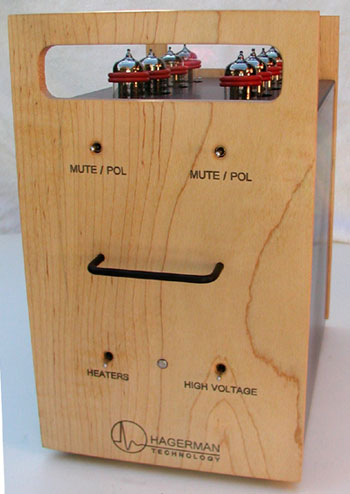
DAVE CLARK'S SYSTEM: LOUDSPEAKERS ELECTRONICS SOURCES CABLES ACCESSORIES
|
 The Hagerman Trumpet phono stage comes
on the heels of the Art Audio Vinyl Reference, which means the best from one tube-based
manufacturer preceding that from one who only makes phono stages. Two of Hagerman
Technology’s phono stages—the Cornet and Trumpet—are based on tubes. The
Cornet is a kit of sorts that can be built for a few hundred dollars, but the Trumpet is
the pinnacle of what Hagerman can do at this point, and reflects his position on what a
phono stage should be. The Trumpet is not like any other phono stage in terms of looks and
basic construction. Why is it so different? When I asked Jim Hagerman if he could
elaborate on the design of the Trumpet, he pointed me to a self-interview on his website,
so I have pulled his answers to his own questions, substituting my own questions:
The Hagerman Trumpet phono stage comes
on the heels of the Art Audio Vinyl Reference, which means the best from one tube-based
manufacturer preceding that from one who only makes phono stages. Two of Hagerman
Technology’s phono stages—the Cornet and Trumpet—are based on tubes. The
Cornet is a kit of sorts that can be built for a few hundred dollars, but the Trumpet is
the pinnacle of what Hagerman can do at this point, and reflects his position on what a
phono stage should be. The Trumpet is not like any other phono stage in terms of looks and
basic construction. Why is it so different? When I asked Jim Hagerman if he could
elaborate on the design of the Trumpet, he pointed me to a self-interview on his website,
so I have pulled his answers to his own questions, substituting my own questions:
DC: Why is the Trumpet designed as a "tower" rather than as a more conventional left-right type of layout?
JH: This was not an exercise in trying to find something different for the sake of marketing. Yes, I wanted my product to have some personality and identity, but certainly not at the expense of sound. What happened here was the result of a study into power supply/amplifier interaction. I didn't like the common side-by-side approach in most gear. The stray magnetic and electrical fields are asymmetric about the channels and external interconnects. I didn't like the imbalance of the fields, which would favor one of the channels. You also have to be aware of how a customer's interconnects and power cords will drape out of the rear of an amplifier. Is the power cord right next to an audio signal? (I'm amazed at how much this happens!) Where will the power transformer sit in relation to the input tubes or turntable and cartridge? These are all aspects of design that I take into consideration.
The usual answer is a two-box approach. That is, a separate power supply. This can work just fine, but it also tends to break up the "star" ground at the input. It is also more expensive. Alas, engineering is the art of compromise. There are many solutions and each designer attempts to achieve their own goals in their own fashion. Wanting to keep the price down, I chose a single-box topology. The best way to accomplish this was with an over-and-under concept where the power supply was mounted under the amplifier. They are kept as far apart as possible with several layers of shielding between. Functionally, it's very much the same as separate, but stacked, boxes. Hey, why pay for the extra chassis?
You'll notice that the shape is that of a golden section. This is to minimize structural vibration colorations. Don't quote me, but I've heard or read that the golden ratio (1:0.618) is an optimum design for mechanical resonance, as is a sphere. The width/height is built to the golden ratio. So are the circuit boards. Anyhow, that's why the Trumpet looks the way it does—golden ratios with a power supply mounted symmetrically underneath the amplifier separated as far as the chassis will allow.
DC: Is there a Hagerman sound? That is, do you have a perception of what a phono stage should sound like, or for that matter not sound like? I ask this because the Trumpet does not sound like a tube unit in the classic sense.
JH: I do not "voice" my amplifiers. That is, I do not tweak or tune or purposely adjust for a particular sound. Rather, I optimize the components and circuits to work together to achieve a pure and transparent gain. Ideally my amplifiers strive to have no sound or tonal contribution of their own.
Of course, it is impossible to make a perfect amplifier. There are compromises to be made. One cannot achieve infinite bandwidth or zero noise. There are also tradeoffs in cost, size and functionality (usually). This is the "art of engineering" as I see it. When designing an amplifier or product, I continually try to explore the various combinations and potential avenues of circuit topology and component selection. It's like a game of chess where each move can explode into a huge number of possible scenarios. Often I go in a big circle and end up right where I was. The difficult part is finding a balanced solution that satisfactorily addresses each goal. It is important to understand that there are many solutions, some better than others, and that each designer applies their own unique skills and knowledge to come up with the end result.
DC: Why the wood faceplate as opposed to "audio jewelry"?
JH: This is not just any wood. It is hard white maple, a very strong hardwood with a very fine and non-porous grain. At first glance, it appears that the wooden front and rear panels are just for show. But that's just part of the story. They also provide mechanical damping to the aluminum chassis. Tap anywhere on this chassis and all you'll hear is a dull thud. No ping. No ringing.
DC: You mentioned that vibration and resonance are key issues. Could you elaborate on this?
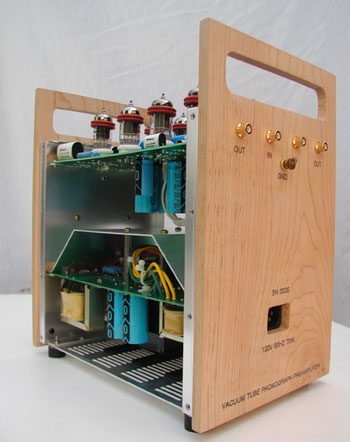
JH: The chassis is built like a suspension bridge. The front and rear panels act like rigid support towers. The high-grade fiberglass circuit boards are hung in between. The amplifier board has no center supports and is free to flex, the fiberglass being naturally self-damped. Under the support towers are sorbothane feet that provide a high level of cushion and decoupling from the mounting surface. Inside the black anodized aluminum cover are strategically placed rubber strips to keep the panels from acting like cymbals. They are also securely fastened to the front and rear towers via an army of screws. Tubes wear O-rings to reduce acoustic energy on the glass. Everything is designed to work in unison to provide minimal microphonic distortion. This is not your average steel box.
DC: The Trumpet’s circuit layout has to be one of the cleanest and slickest around. What is was the idea behind this? Are you a neat freak or what?
JH: The first thing you see with the cover off is a remarkable lack of wires. The Trumpet does not look like any other audio product. Often you'll see a mass of wires routed all over the chassis. I am just appalled at some of the equipment I see out there, with signal and power wires criss-crossing all over the place between controls, boards, and connectors. A virtual smorgasbord for unwanted coupling and interference, not to mention a completely haphazard grounding scheme.
The Trumpet's rear aluminum panel acts as the "star" ground and reference for all other signals. This is where the input and output connectors are, the turntable ground, and the Earth ground connection from the power cord. From this single low impedance plane, the ground spreads through the chassis. There are no loops—that was not easy. The circuit boards use full ground planes. But note, the signal and power grounding maintains a "star" configuration by judicious control of currents. Hey, it's not where the metal is, it's where the electrons are flowing. Not only do the signals on the circuit boards have solid reference points, but the ground planes also act as electric field shields. Even the power cord is specially double-shielded.
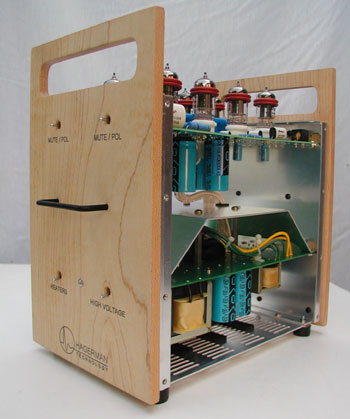
DC: This thing is very heavy, way heavier than one would think, and when you realize that an external step-up transformer is still required for low-output MC cartridges, what’s the deal?
JH: I use a huge amount of iron in the power supply. That is, big transformers and chokes. This is no ordinary power supply. Not only is it choke filtered, but it is balanced. I use both B+ and B- supply rails. The preamplifier runs off +/-300V supplies, but first I want to point out that these are not simply choke filtered. They are choke regulated. Most supplies are designed so that the rectifiers charge up capacitors 120 times a second. In the Trumpet, the rectifiers charge up inductors instead. There is a big difference between these two types of input filters. A properly designed inductive input will maintain a continuous AC mains current. This is in contrast to the large short-duration current spikes (dozens of peak amps) observed in most equipment. Ever wondered where power line "buzz" came from?
To reduce supply ripple down into the uV range (starting at 350V), additional LC and RC filter stages are added. Active regulation is not used. Each high voltage rail gets smoothed by a total of LCLCRCRC filters. Component values are not just pulled out of a hat. These are very carefully designed sections that work hand-in-hand with the load. Inductor values are determined by the minimum load current theory. Capacitor values must be carefully chosen to react with the series equivalent resistance of the chokes for proper damping. Yes, an LC filter is a nice low pass filter, but if undamped will lead to ringing. Therefore, the capacitors must be correctly sized. The Trumpet supplies are set to be slightly overdamped (closer to Bessel than Butterworth). This prevents power line spikes from stimulating ringing in the filters. It also helps that the preamplifier acts as a constant-current type load.
In a bold innovative move, I also made the heater supply choke regulated. As far as I know, nobody else is doing it. This is a great trick, which I believe will be copied by many. By simply running the 5V and 6.3V secondary windings in series, a full-wave rectified choke type input filter provides a decent DC output voltage without any of the huge AC current spike getting yanked down the power cord. Again, carefully designing an LCRC filter for no resonance, I got a DC output voltage with less than 5mV ripple. A side benefit is the gentlest heater turn on in the industry. This is important for long tube life and product reliability.
So that's why it's heavy. Lots of iron to smooth out the supplies and prevent AC mains current spikes. Unfortunately, it is also very expensive.
DC: What is the overall circuit design? Class A, single-ended, fully balanced?
JH: The circuits are fully balanced— differential throughout. As such, each stage draws a constant current from the supplies regardless of signal. Differential circuits also reject common mode noise from the supplies or other unwanted external influences. The constant current load is almost like shunt regulation for the supply filters. They maintain low voltage ripple under load. I even pulled a small trick whereas even if the line voltage changes (wanders up and down), the bias of the tubes remains constant. That is, perfect first order power supply noise rejection. But this works only down to about 1Hz, which I feel is good enough for audio.
Balanced amplification also allowed me to add polarity controls. With both positive and negative-going signals, you can pick which one to use to correct for system or source irregularities. Differential amplifier stages are just plain a better topology. The only drawback is that you double the number of tubes and increase cost.
DC: The polarity switches are a real cool addition. I really noticed a major change for the better, when they were either in or out depending on the LP spinning at the time. I also noticed that you went for the premium stuff here.
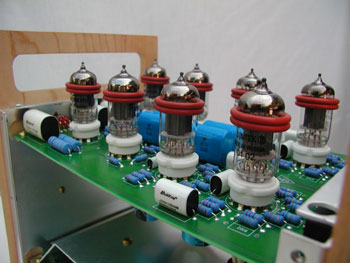
JH: Premium quality parts are used throughout. The RCA jacks are gold plated, so are the sockets. All signal capacitors are audiophile-grade polypropylene types, supplies are bypassed with film capacitors, resistors are power metal films, and power supply diodes are soft-recovery types. Even the mute switches use expensive low-current gold contacts. Holding all of this together is lead-free solder. It is much harder to work with and does not produce shiny joints, but provides a much better and lower impedance weld. Believe me, I would not work with the stuff if it didn't sound better.
DC: What is your position on feedback?
JH: I use feedback a lot in other jobs. Motion control, lasers, video, power supplies, my VacuTrace—they all take advantage of feedback. But for sonics, well, you can just plain hear more than what can be measured. Feedback in itself isn't necessarily evil. The problems are caused by implementation. A poorly designed feedback amplifier will have high frequency instability, slew rate distortion, and create additional harmonics due to the never-ending application of output signal back into the input. Sometimes you can do pretty well. Feedback with tubes is not easy. Usually it is of the current feedback variety, used to tame an extremely nonlinear pentode output stage. Most designers don't even realize it is a current feedback topology (back to the cathode of input tube). They apply some capacitance in parallel with the feedback resistance—very bad. Just as awful, the feedback is applied over three gain stages, each with their own high and low frequency phase shifts. Yes, feedback can cause low frequency problems too, such as "motorboating". If you're designing with op amps, you have to use feedback. Tubes offer such inherent linearity (especially triodes), that a properly designed amplifier can operate without any feedback. Notice I said "properly."
DC: The Trumpet is not the last word in user-friendliness, in that loading and such cannot be adjusted easily. With the Trumpet, one has to change resistors as opposed to either DIP switches or some other means. Why?
JH: This really only applies to phono stages. Many manufacturers put DIP switches or maybe even a fancier switch to select various capacitive and resistive loading of a cartridge. I don't, for two reasons. First, I try to reduce the number of metal-to-metal connections when the input signals are so low (uV range). Any metallic junction made by pressure (and not by alloy or soldering) is prone to noise and distortion. Incompatible metals, corrosion, dirt, and other contamination reduce the effectiveness of the electrical contact. A good connection must be gas tight and use high quality and appropriate metals. Gold is the best. That's why everybody uses it. Very inert, soft. Adding selector or loading switches increases the possibility of signal degradation. Imagine spending $1000 on high quality interconnects and connectors just to send the signal through a flimsy plastic DIP switch. I like to eliminate the galvanic and thermoelectric errors caused by junctions. Secondly, I don't feel a cartridge should be loaded with its maximal permissible capacitance. The true ideal should be zero—that is, if you desire wide bandwidth with minimal phase distortion (fidelity). But zero is impossible, so best just to minimize it. Use low capacitance interconnects and low capacitance phono preamp input. Having done that, you wouldn't need to lower the load resistance, which damps the high frequency peaking caused by capacitance.
So how does the Trumpet stack up to the competition? As I said, the Trumpet came on the heels of the Art Audio Vinyl Reference, and it was difficult to believe that two reference quality, tube-based phono stages could not only sound so different, but so wonderful. While the Reference had that characteristic tube bloom and laid-back perspective, the Trumpet was way more "solid-state-like," in that it was big and dynamic, with a well controlled and powerful bottom end, along with a speed and clarity across the midband that was truly captivating. The Trumpet was tonally similar to the E.A.R. 834P that I am currently using, but bettered it in terms of the ease and refinement of the musical message, as well as in soundstaging. The Trumpet was much bigger-sounding, putting the music out into the room and extending way beyond the edges of the speakers. This was way more upfront and personal—just the way I like it!
The Trumpet had that "solid state" sound with respect to soundstaging, dynamics, slam, etc., but none of the tradeoffs. It was a smooth and palpable performer that offered an extended and airy treble without a hint of grain, grit, or transistor hardness. Is it the best of both worlds? Not quite. Hum was an issue. I tried as many locations as I could, but the Trumpet’s idiosyncratic shape limited my options, as well as the routing of interconnects and the AC cord, but the hum was clearly audible from across the room when music was not playing. It was not audible when music was playing, though any added noise has to detract from the overall purity of the presentation. Even more problematic was the fact that the Trumpet sounded a bit slow and a shade too dark in my system. The Trumpet could have been a bit leaner and more open, from the mids on up. I found that it failed to propel many of my favorite Laswell or HiM titles in a manner that the music required to be really appreciated. I never got that desire to tap my feet or to get up and dance the aging white man shuffle. I think much of this is due to the fact that the Trumpet is a tube design, as I hear much the same from my E.A.R. 834P. It’s not a bad thing, more a matter of taste and preference.
On the other hand, I did not hear this from either the Coda .05r, the Sutherland PhD, or the Transrotor phono stage, all here for review, and all solid state. So while the Trumpet does not have the classic tube tendency to be overly rich and laid back (as did the luscious and velvety smooth Vinyl Reference), it still retains much of the tube tonality that is cherished by many. That tonality can be mitigated by choice of interconnects. Using the Soundstring interconnects was not advisable, as they made things even darker and richer, whereas the leaner Nordost Quatro-Fil or Wasatch Ultama came closer to what I wanted to hear. These both helped to minimize the Trumpet’s darkness, adding a bit more transparency and "light" to the tonal palate. Now things could really cook, and many an LP brought a smile to my face. Nevertheless, since I prefer a leaner sound than the one the Trumpet portrays (that of tubes—though in truth, my system is a balancing act, with a synergy that to me says "music playing in the room," and thus falls between the traditional sound of tubes and solid state), it may not be the final step in my pursuit of a phono stage. Even with these two interconnects, the Trumpet sounded far too close to the 834P, and that is not where I am heading at the moment. My system is balanced more to the side of the lean and transparent than the Trumpet will allow.
While Jim Hagerman made the choices he needed to make in the design of the Trumpet, they are not the right choices for me. Aside from the sound, the Trumpet’s dimensions required that the unit sit on the top shelf of my rack, and with the step-up transformer required for my Shelter 901, the setup just did not work. There wasn’t enough room to site things properly, either visually or ergonomically. Also, the fact that changing the loading requires one to solder in various resistors makes the Trumpet rather impractical for me as I move into reviewing cartridges. If you have the right cartridge, ample room to situate a tall phono stage and largish step-up transformer—as well as a system that would mate better tonally with the Trumpet—I can think of no better place to start. The Trumpet makes many an LP sound simply marvelous. It may or may not work for you, but give it a listen! Dave Clark
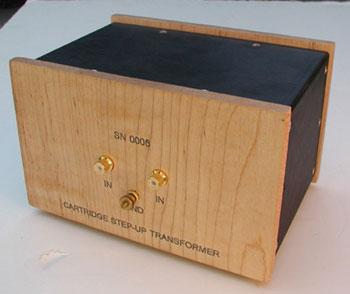
ROBERT H. LEVI'S SYSTEM LOUDSPEAKERS ELECTRONICS SOURCES CABLES ACCESSORIES
|
 It’s the twenty-first century, and
this is the third new phono preamp I’ve reviewed in the last six months! Two of them
have been 100% tube powered, and all three have transformer outputs. The sound of all
three is close to the best I’ve ever heard from vinyl, AND all three sound quite
different. The Trumpet from Hagerman Technology, an all-tube design with a transformer
boost, has the most classic tube sound coupled with many modern tweaks and very low
apparent distortion. This new entry into the phono sweepstakes is the first to delete
chrome and add real maple wood sides front and rear. It looks cool, it bristles with eight
tubes lined up on top, and it provides delicious musical enjoyment to the vinyl lover with
a big vintage LP collection.
It’s the twenty-first century, and
this is the third new phono preamp I’ve reviewed in the last six months! Two of them
have been 100% tube powered, and all three have transformer outputs. The sound of all
three is close to the best I’ve ever heard from vinyl, AND all three sound quite
different. The Trumpet from Hagerman Technology, an all-tube design with a transformer
boost, has the most classic tube sound coupled with many modern tweaks and very low
apparent distortion. This new entry into the phono sweepstakes is the first to delete
chrome and add real maple wood sides front and rear. It looks cool, it bristles with eight
tubes lined up on top, and it provides delicious musical enjoyment to the vinyl lover with
a big vintage LP collection.
I’ll leave the technology to the Trekkies. Suffice it to say that the Trumpet features four 12AX7s and four 12AU7s, all seated on top to facilitate tube rolling. The tubes are all select Russian types, matched and graded for best sound and lowest distortion. As a result, I did not have sufficient tubes on hand to try swapping. Hookup is straightforward via the provided single-ended outputs. (Balanced outputs are available as an option, though the test unit did not have them.) The outboard transformer box is necessary even with medium output moving coils like my Benz Ruby 2H at .8mv, so all listening was done that way. I did listen without the transformer for a while, and it sounded identical but without dynamics. The transformer is very high quality and without obvious flaws.
I liked the Trumpet’s mute and warm-up facilities, as well as the polarity switches. Though all cartridge adjustments must be done internally with a soldering iron to keep distortion at a minimum, the other two phono stages I reviewed featured outboard adjustments. The Trumpet came set at 47k and minimum capacitance, and that was what I used. The Trumpet is not the best choice if you have a variety of cartridges and are ham-handed like me. It is not very sensitive to AC or interconnect cable choices—I chose Tara AC and Kimber interconnects. The unit did not sound different no matter where it was placed, which demonstrates good attention to detail.
Hum
You must plug the Trumpet into the same AC circuit as your preamp or it will hum mightily. If you do, it’s almost as quiet as the best tube designs I’ve encountered, quiet enough for critical and enjoyable listening on speakers of low to medium efficiency. I’d audition first if you run horns. It hums when muted, though this is easy to overlook.
Balance
The review sample was slightly louder in the left channel. There is no on-board adjustment for this, but I tweaked my amp outputs very slightly to compensate. I’ve seen this before in tube designs. Low-level signals are a bear, even if you carefully match your tubes.
Dynamics and pace
Very good to excellent. The Trumpet is wonderfully dynamic, with plenty of drive and pace. Duke Ellington, Blues in Orbit (Columbia CS8241, Classic Records reissue), is powerful jazz with blatty horns and strong bass lines. The Trumpet provides excellent snap and jump, some of the best I’ve heard. You can’t help but tap your feet while listening.
Musical accuracy and coloration
Very good. The Trumpet skews to the warm, wet side of accurate. Listening to What’s New (Elektra 60260), with Linda Ronstadt and Nelson Riddle’s Orchestra, you immediately hear the romantic, caramel quality of the voice and orchestra. The colorations are in the notes, not obscuring the notes. Its not a gray scrim such as the one you hear in lesser ARC designs. The sound is very transparent, enriched with warm, cabernet sauvignon overtones. This coloration is always present, and adds to the enjoyment of most LPs, but it is a coloration.
Transparency
Very good, though the added warmth also darkens the air and ambience. Spatial cues are obscured, as is depth. The instruments float in your listening room rather than in their recorded environment. In This One’s for Blanton (Pablo 2310-721), with the Duke and Ray Brown playing jazz duets, the studio space they are playing within is not easily apparent through the Trumpet. The piano and bass are clear and euphonic, though not within their original environment. The piano lacks jangle and attack, sounding somewhat more golden than as recorded. The bass is excellent, tight and musical. Its hollow, wooden character is slightly obscured, though still realistic.
Bass
Very good to excellent. As good as any tube design I am familiar with. Listening to a mint pressing of Country Gardens (Mercury 90219), an LP of Percy Grainger melodies, the bass impact and clarity are excellent. There is no smear or sense of tube bloom. This is quite an accomplishment for an all-tube design at any price. The warm, euphonic colorations of the unit affect the bass much less than any other part of the musical spectrum.
Treble and mids
Very good. Listening to Song of Democracy (Mercury 90150), the chorus is well defined and spreads across the room just behind the orchestra. The words are easy to understand. However, the hall ambience is not clear, and air is not readily heard. I found myself pushing the volume to hear more, but never really heard the space around singers, etc., as clearly as I’m used to. All was certainly enjoyable, with no real emphasis at any frequency. The LP sounded like it was recorded forty-plus years ago. There was plenty of that romantic, old Telefunken sound, but I’m used to more definition and space than was apparent here.
Conclusion
The Trumpet is a refined phono stage providing plenty of musical pleasure for the LP enthusiast. It’s not the last word in neutrality or flexibility, but it’s priced accordingly. It wears its badge as an all-tube design with pride, and won’t disappoint the seeker of that elusive quality of LP reproduction. I enjoyed my time with the unit, and felt my Benz Ruby was well served. Order it with balanced outputs if your preamp is capable, though hum and noise was very low. Tube swapping is easy, and looks to be as entertaining as the listening. The Trumpet should be on your short list of phono stages to try under $3000. Robert H. Levi
Trumpet phono stage
Retail: $1895
Step-up transformer
Retails: $895
Hagerman Technology
TEL: 808. 383. 2704
email address: [email protected]
web address: www.hagtech.com
